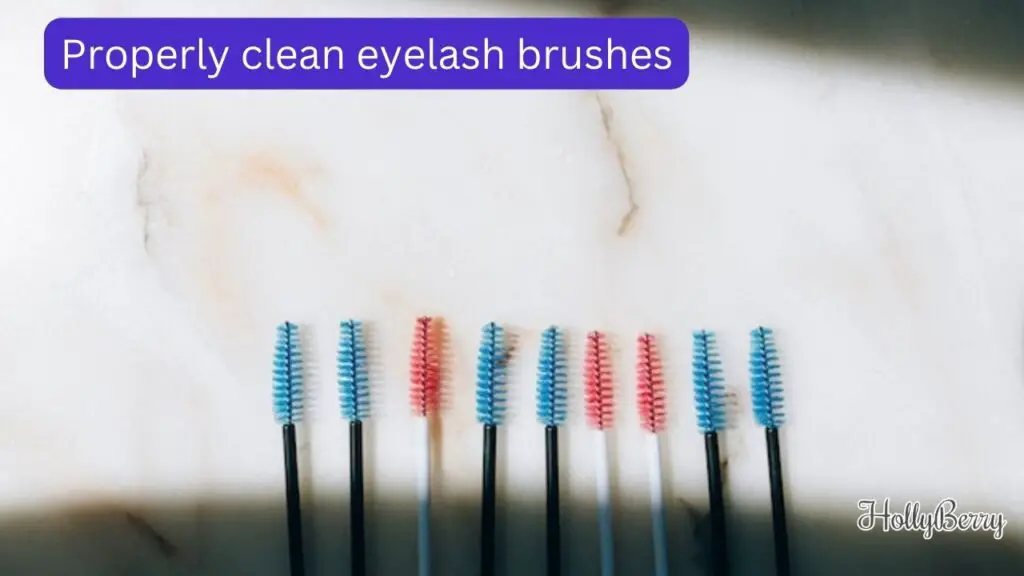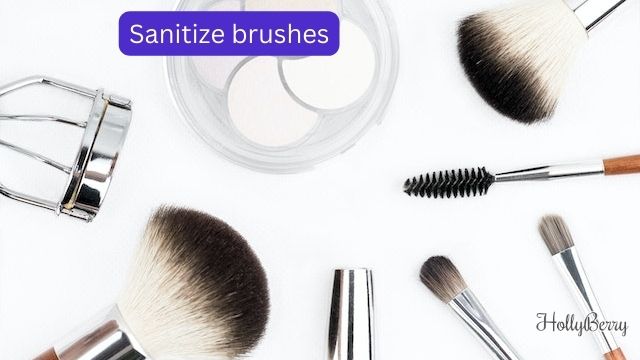
Understanding the importance of regularly cleaning eyelash brushes is key to maintaining healthy and beautiful lashes. Eyelash brushes, especially mascara wands, can accumulate makeup, dirt, and bacteria over time.
If not cleaned properly, these brushes can cause irritation, infection, and even damage to the lashes. Regular cleaning will not only keep the brushes in good condition, but also it will keep your lashes healthy and looking great.
Additionally, dirty brushes can transfer bacteria and other harmful microorganisms to your eyes, which could lead to eye infections, irritation, or conjunctivitis.
By cleaning your eyelash brushes regularly, you can ensure that they are in good condition and that you are avoiding any potential health risks.
The best cleaning solutions for eyelash brushes
When it comes to cleaning eyelash brushes, there are a few different options to choose from. One of the simplest and most effective ways to clean your eyelash brushes is to use mild soap and lukewarm water.
Another option is to use a brush cleaner specifically formulated for cleaning makeup brushes. This type of cleaner is gentle on the bristles and effectively removes dirt, oil, and makeup.
You can also use a solution of isopropyl alcohol and water. Mix 1 part alcohol and 3 parts water, then dip the brush in the solution and swirl it around to remove any dirt or bacteria. Be sure to rinse it thoroughly with water afterwards.
Please note that you should avoid using harsh chemicals or abrasive materials to clean your brushes, as these can damage the bristles and cause irritation to the eyes to make sure to dry the brush well after cleaning, as leaving them damp can harbour bacteria and mould.
How to remove excess mascara from eyelash brushes
Removing excess mascara from eyelash brushes is important to keep them in good condition and ensure that they apply mascara evenly. Here’s a quick guide on how to do it:
- Start by wiping the brush on a clean tissue or paper towel to remove as much mascara as possible.
- Next, use a small amount of makeup brush cleaner or mild soap and lukewarm water to gently clean the brush.
- Gently massage the bristles with your fingers or a brush cleaner tool, and make sure to remove any dried mascara that may be stuck in the bristles.
- Rinse the brush thoroughly with water and then dry it with a clean towel or tissue.
It’s also a good idea to clean your mascara brush after each use, this will prevent the buildup of mascara, dirt and bacteria on the brush. You can also use a brush cleaner spray in between washes to keep the brush clean and hygienic.
By removing excess mascara and cleaning your brushes regularly, you can ensure that they apply mascara evenly and last longer.
How to properly dry eyelash brushes
Drying properly is essential for maintaining their shape and quality. Here’s a quick guide on how to do it:
- Gently squeeze any excess water from the bristles using a clean towel or tissue.
- Then, lay the brush flat on a clean towel or tissue to air dry.
- Avoid leaving the brush standing upright while it dries, as this can cause the water to run down into the ferrule (the metal part that holds the bristles) and loosen the glue that holds the bristles in place, which can lead to shedding.
It’s also a good idea to reshape the bristles with your fingers while the brush is still damp, to ensure that they maintain their shape.
Note you should avoid using hair dryers or other heat sources to dry your brushes as it can damage the bristles and cause them to become brittle. Also, avoid drying them in direct sunlight as it can cause the bristles to become stiff.
How to sanitize eyelash brushes

Here’s a quick guide on how to do it:
- Start by cleaning the brush with mild soap and lukewarm water.
- Next, use a solution of isopropyl alcohol and water. Mix 1 part alcohol and 3 parts water, then dip the brush in the solution and swirl it around to remove any dirt or bacteria.
- Rinse the brush thoroughly with water and then dry it with a clean towel or tissue.
Another option to sanitize your brush is using a brush sanitiser spray, it’s easy to use, simply spray the brush and leave it to dry.
It’s important to note that you should sanitize your brushes at least once a week, especially if you have sensitive eyes or are prone to eye infections. You should also sanitize your brushes if you notice any signs of irritation or infection.
By sanitizing your eyelash brushes, you can ensure that they are hygienic and safe to use, and avoid any potential health risks.
How to properly store eyelash brushes
Here’s a quick guide on how to do it:
First, make sure that the brushes are clean and dry before storing them. Second, store them in a clean, dry place. Avoid storing them in humid or damp areas, as this can cause the bristles to become mouldy or damaged. Third, Store them in a case or container that will keep the brushes separated and protected.
Fourth, Keep them away from direct sunlight, as it can cause the bristles to become stiff.
It’s also a good idea to store eyelash brushes separately from other makeup brushes to prevent cross-contamination. By properly storing eyelash brushes, you can ensure that they maintain their shape, and quality, and are hygienic to use next time.
The dangers of not cleaning eyelash brushes
Definitely! The dangers of not cleaning eyelash brushes are many and can be harmful to your eyes and lashes. If you don’t clean your eyelash brushes regularly, they can accumulate dirt, bacteria, and other harmful microorganisms.
This can cause eye infections, irritation, and even damage to your lashes. Dirty brushes can also transfer bacteria and other harmful microorganisms to your eyes, which can lead to eye infections, irritation, or conjunctivitis.
Additionally, not cleaning your brushes can also cause the bristles to become stiff, which can make it difficult to apply mascara evenly and can cause the mascara to clump. Not cleaning brushes can also cause the mascara to dry out and become ineffective.
Furthermore, not cleaning your brushes can also shorten their lifespan, as dirt and bacteria can cause the bristles to break or become loose, making the brush ineffective.


